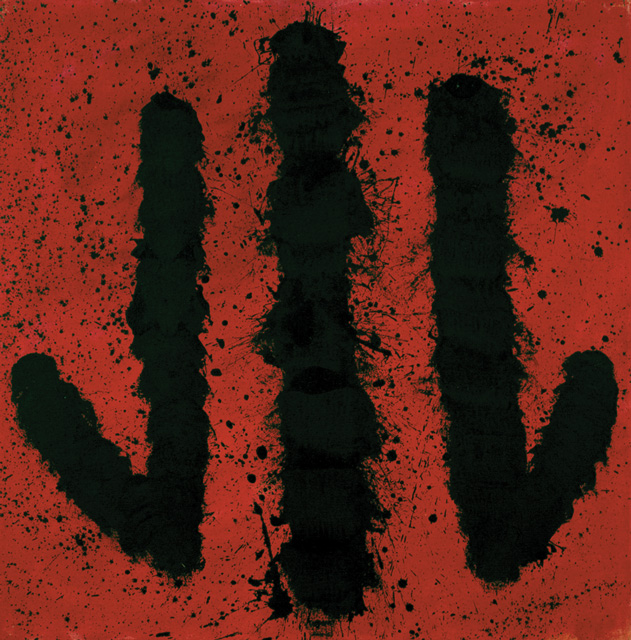


This work tracks a dramatic new departure in Indigenous art at the end of the 1990s. Michael Nelson Jagamara is one of the most versatile of Western Desert painters, famous as the designer of the contentious mosaic for the forecourt of Parliament House in Canberra. A Warlpiri man who has long lived at Papunya (home of the Indigenous acrylic painting movement, begun in 1971), Jagamara began painting in 1983 and won a major Aboriginal art prize the following year. His complex but forceful, crisply laid-out dot paintings became internationally recognisable Australian works in the later 1980s.
In the next decade the demand for Jagamara's art meant 'he was often found rushing works', some of which looked 'tired and barren'.1 Experimenting at the Campfire Indigenous Art Collective in Brisbane, around 1998 he swapped the close work of dotting with a stick-end for images comprising a few sweeping brush-strokes, energetically applied in black ink to art paper. Jagamara probably looked to the example of Emily Kam Kngwarray, who had moved from dot paintings to rapidly done gestural works in 1995.
Kangaroo (1999) exemplifies this 'New expressions' series of freehand drawings and paintings. Rather than telling a story using tracks and icons for the different totemic Dreamings that he is entitled to use, Jagamara blows up the graphic sign for one specific totem. The sign for 'kangaroo' has been used for many centuries by Warlpiri and other desert peoples in sand-drawing with the fingers to illustrate the telling of stories. The two hooked bars are the hind legs imprinted on the sand, while the central groove is made by the kangaroo's tail. Such an icon can refer to the animal both in its 'tucker' guise (as prey), and in its ancestral guise as a mythic creator-being.
The work draws on traditional culture, yet is contemporary art that makes a bridge to western art values. Jagamara's spectacular large drawings, in which the impact of the brush splatters jets of ink to the very edges of the paper, link visually to abstract expressionist artists like Franz Kline (himself inspired by ancient Chinese calligraphers). Jagamara probably knew neither tradition, but the reference helps explain the western taste for his 'New expressions'. Jagamara's big acrylic paintings generate their visual energy through the complementary contrast of colours—purple on yellow, for example, in his Wild yam (1998)—as well as splatter brushwork.
Kangaroo has the same stripped-back visual energy, derived from black paint whacked onto the canvas coated in vivid red. A video recording shows the artist standing above a similar canvas laid on the ground, forcefully striking the canvas with a loaded brush. The sonic link to the impact of the leaping beast striking the earth cannot be missed. Although a single ideogram cannot encapsulate narrative as such, and although the artist has said 'without the story, the painting is nothing', the impression of meaningfulness is nevertheless present.2 Just as the Christian cross encapsulates the story of the crucifixion, so the kangaroo print could, for an initiated Warlpiri person, encode the creation stories of the Kangaroo-ancestor as a mnemonic or memory device.3 For the non-Indigenous viewer, this emphatic visual statement can resound with the possibility of meaning in the spiritual dimension of another culture.
- Roger Benjamin
Michael Nelson Jagamara is represented in Australia by FireWorks Gallery, Brisbane.